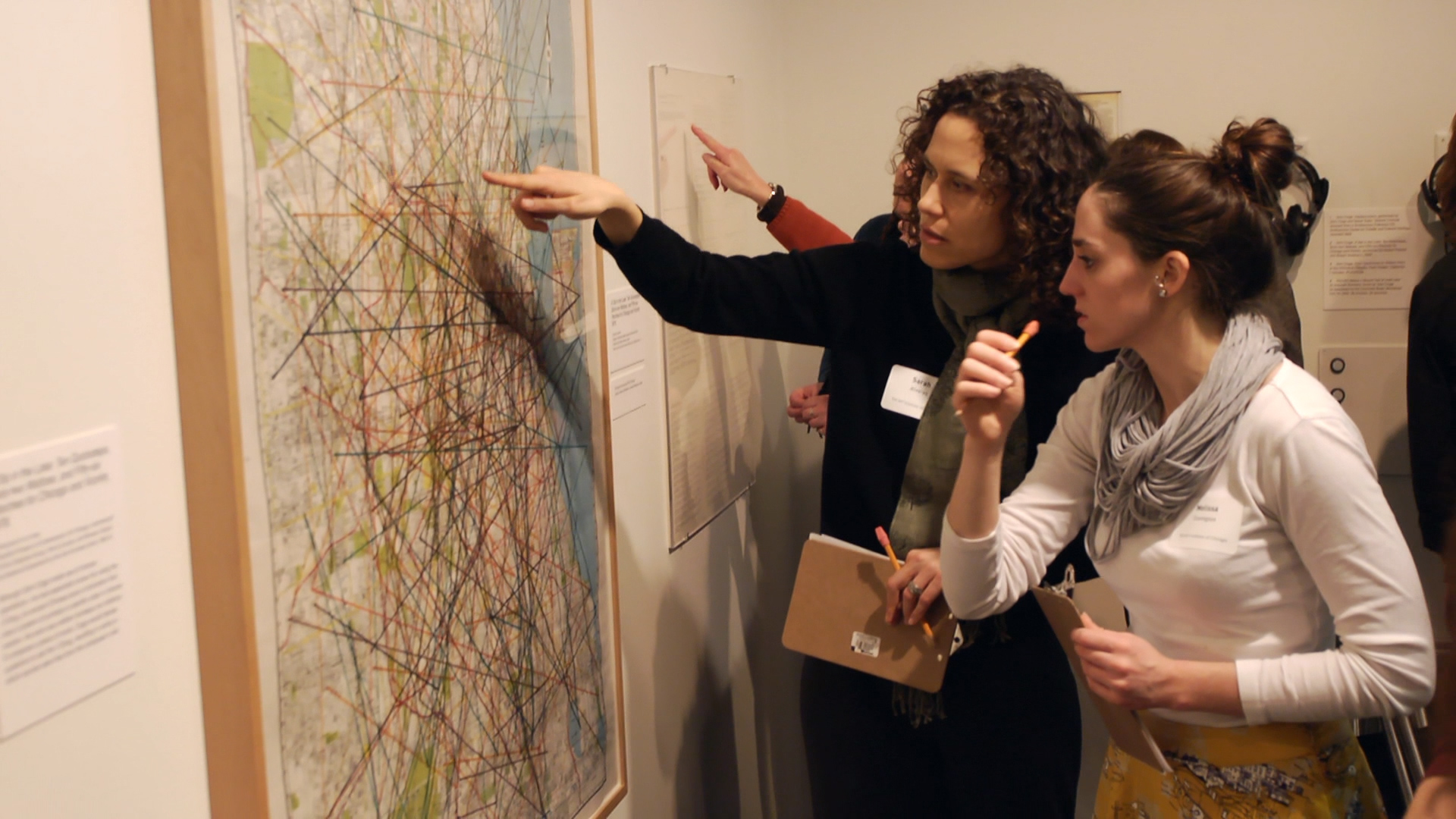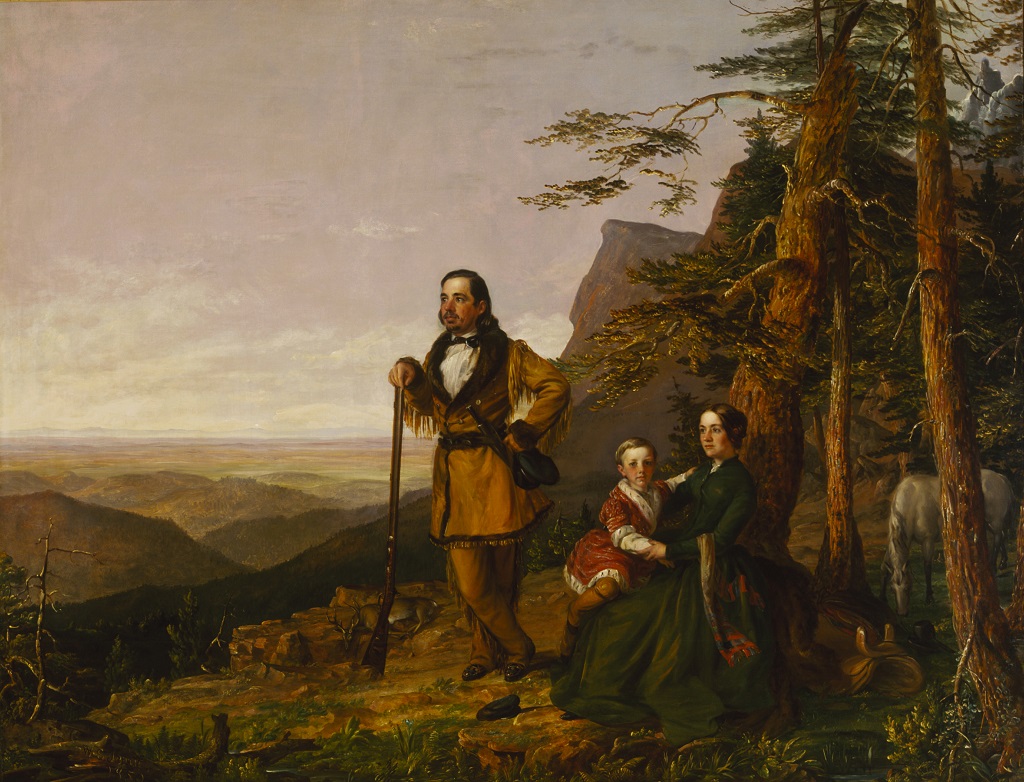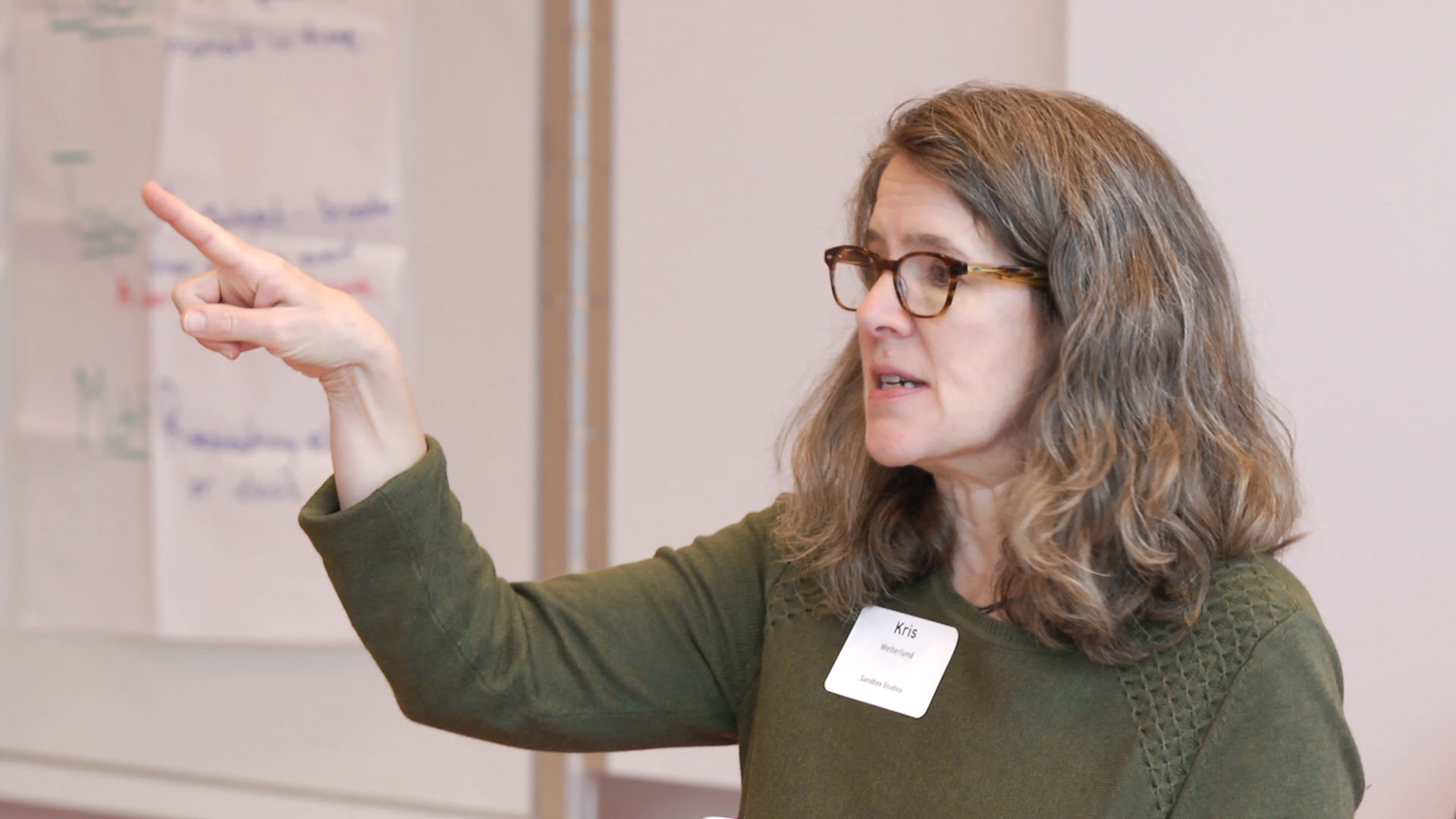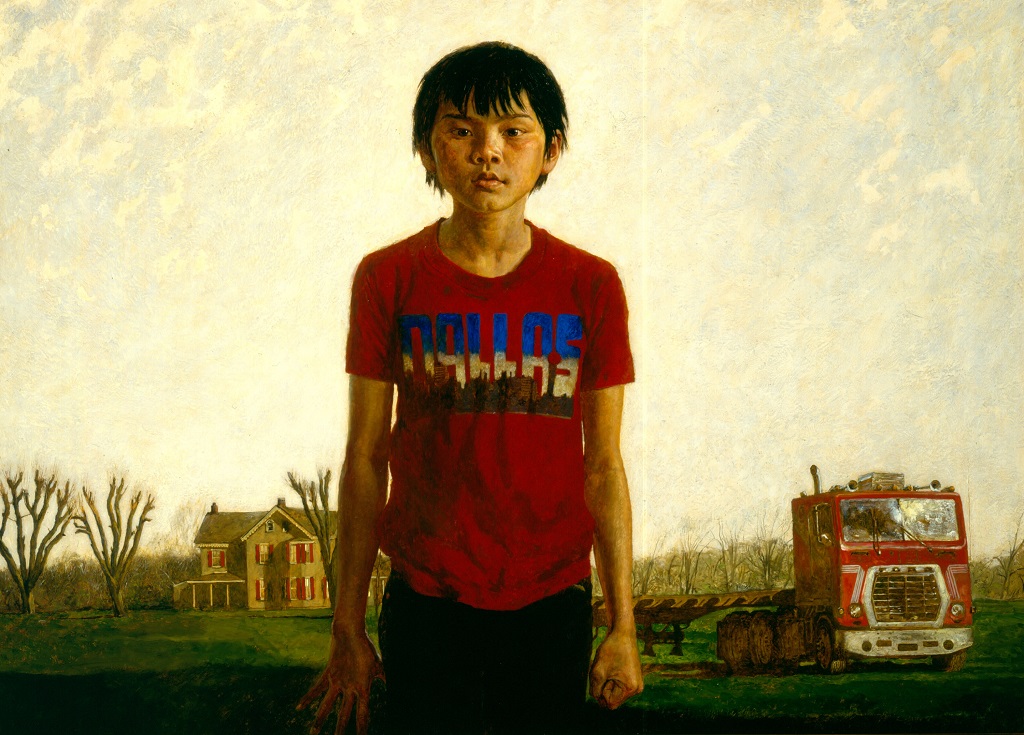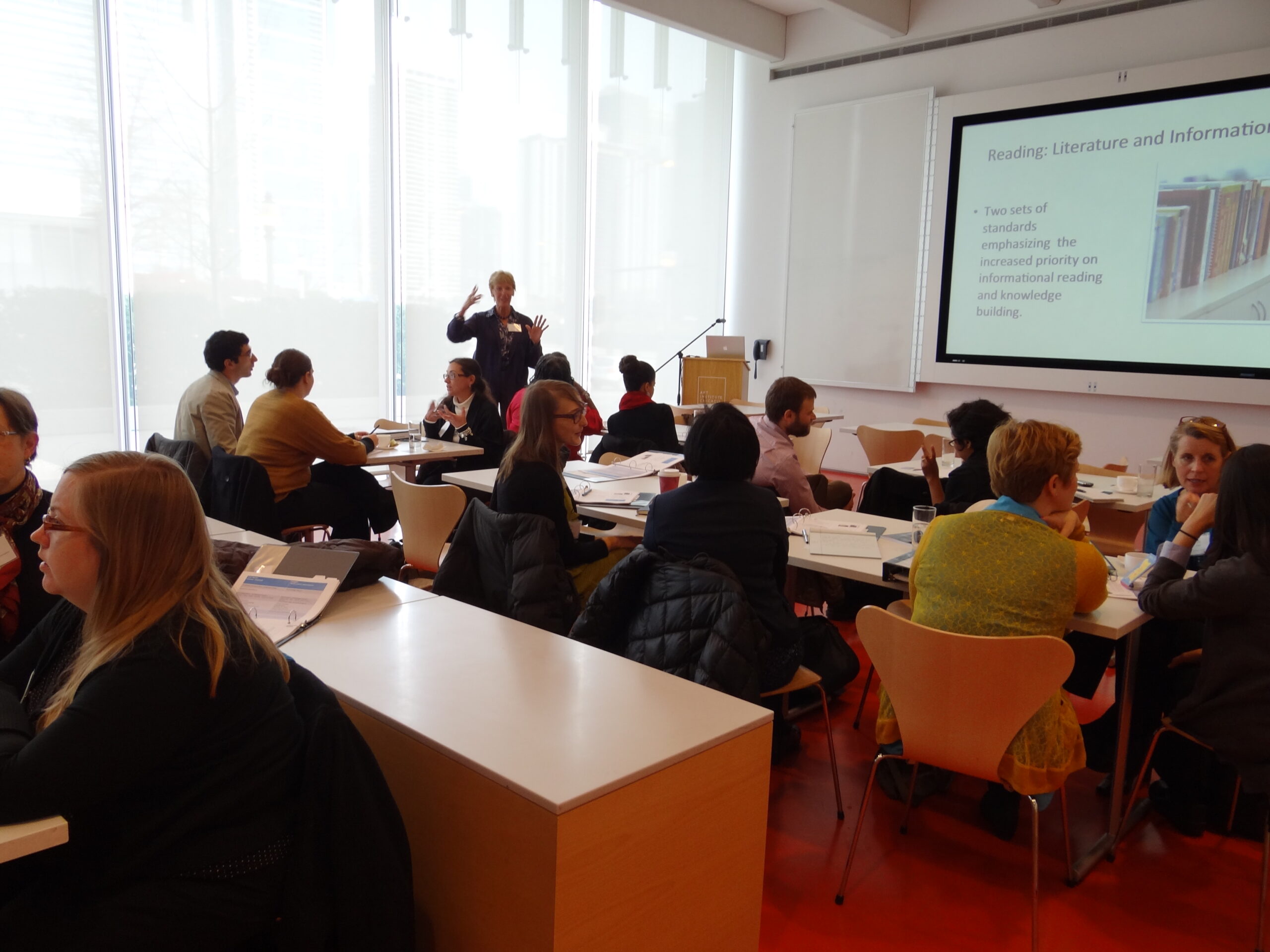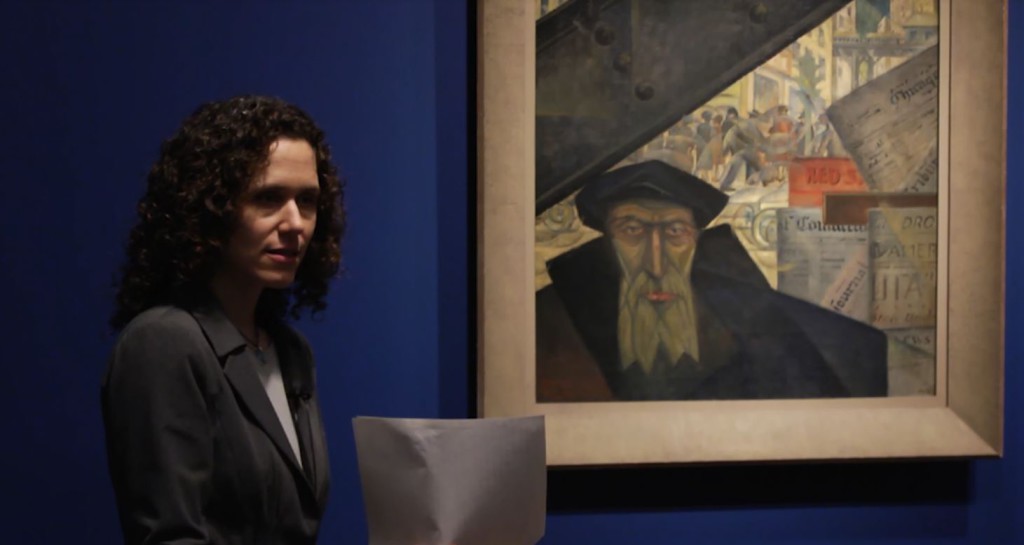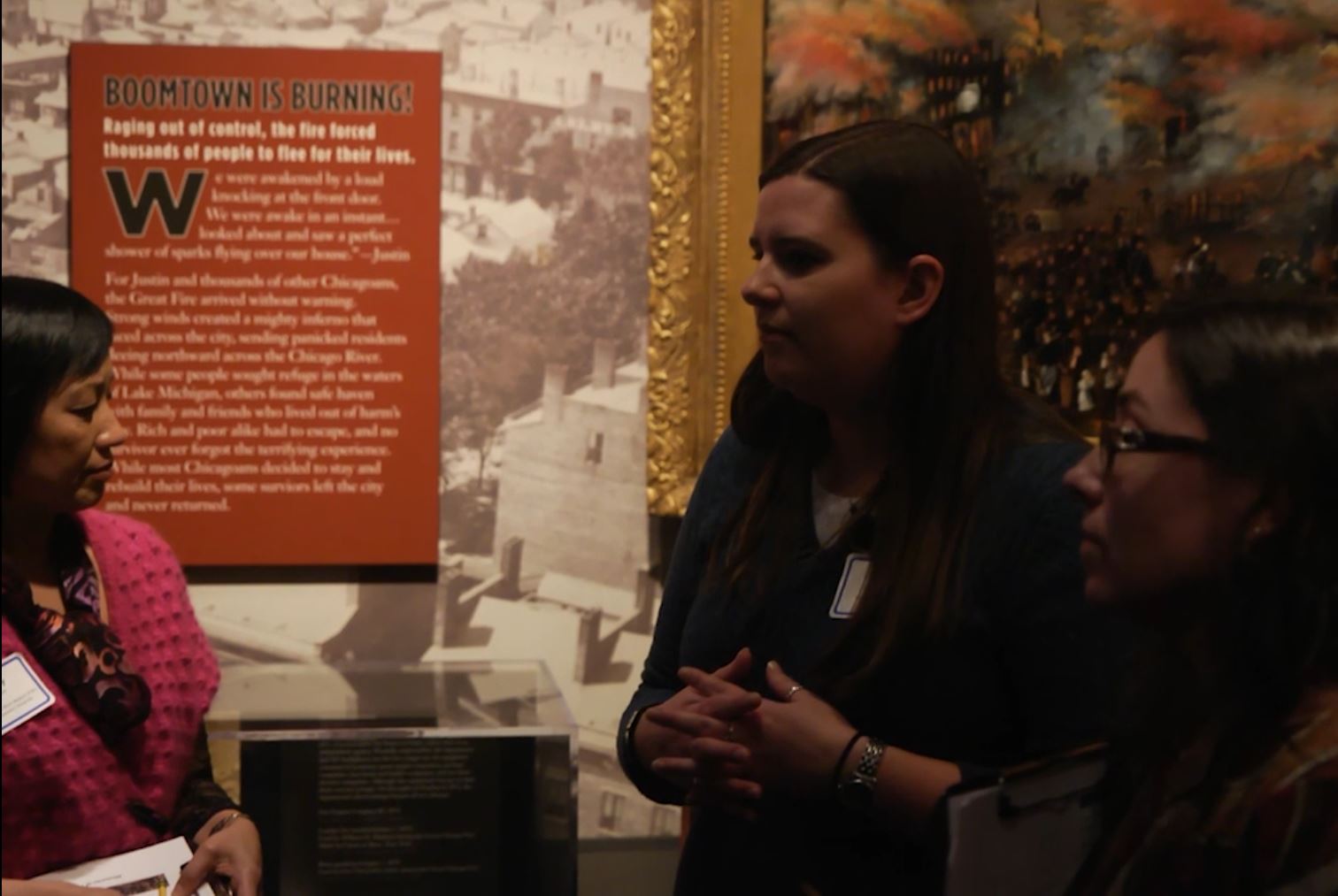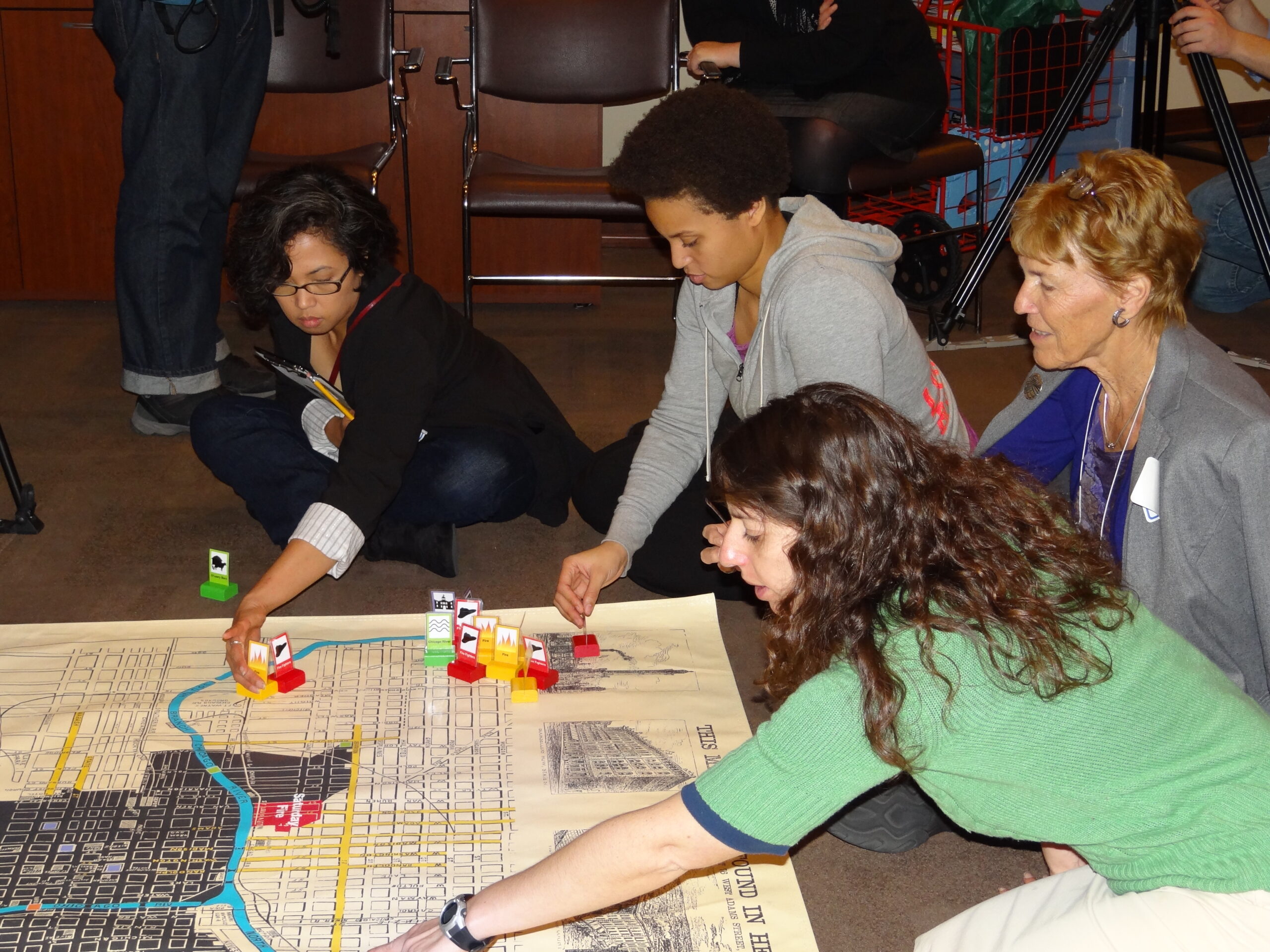Art Inquiry + Common Core Anchor Standards in Reading
Below are sample questions—each aligned with a Common Core Reading Anchor Standard—that can be used with students to analyze and interpret works of art. Many of these questions came from the modeling of museum-teaching practice that took place in American Art at the Core of Learning, a learning community for museum educators in Chicago organized and sponsored by the Terra Foundation for American Art. These questions—many long used by museum educators—support the practice of reading closely and thinking analytically that is specifically called for in the Common Core State Standards (CCSS). The standards also call for teaching with diverse text types, including visuals, and for reading across texts. This resource is intended to help teachers incorporate American art in their teaching repertoire in ways that address the standards.
Download this guide as a pdf here.
Key Ideas and Details
CCSS-ELA Reading Anchor Standard 1: CCSS.ELA-LITERACY.CCRA.R.1
Read closely to determine what the text says explicitly and to make logical inferences from it; cite specific textual evidence when writing or speaking to support conclusions drawn from the text.
Note: Interpreting works of art involves the same processes described above. Students view a work of art carefully to determine what the artist has presented and what inferences can be logically be made from what they see; they should identify specific aspects and elements of the piece, including technique and structure, to support their conclusions.
Reading Closely:
Note: The discussion leader should help to provide an atmosphere of comfort for the group—and give students time to carefully “read” the work of art. Students are encouraged to share their perceptions; there are no right or wrong answers.
- Spend a few minutes looking closely at this work of art, noticing ______________.
[OR] Spend a few minutes looking closely and write down 5 things you notice.
- Now, let’s discuss what you observe.
- What else do you see? (directed to an individual or the group)
- Look at ________ (a key detail or section of the artwork). What do you see here?
- Why do you think the artist included these elements?
- What do you think the artist is showing?
- What questions do you have about what you see?
Note: At the end of group discussion, the discussion leader can prompt or direct students’ attention to any other important aspects of the piece that were not mentioned by the group.
Making Inferences:
- What do you think the artist wanted to communicate? What do you see in the artwork that makes you say that?
- What can the image tell you about the artist (photographer, painter, sculptor, etc.)? What do you see that makes you say that?
- What do you imagine could have happened moments prior to [or after] the scene shown here? What in the artwork made you say that?
- What does this remind you of? Explain your response.
- If this artwork produced sounds, what would they be like? Describe (or make) them and explain your thinking.
- What feeling or mood do you get from this artwork? What about it makes you say that?
- What is the setting for the artwork– the time and place? What makes you think that?
- What words help to describe this artwork?
Note: After sharing an important fact about the artwork or artist, ask the question that follows: Does knowing [x information] change what you think about this work of art? If so, how and why?
CCSS-ELA Reading Anchor Standard 2: CCSS.ELA-LITERACY.CCRA.R.2
Determine central ideas or themes of a text and analyze their development; summarize the key supporting details and ideas.
Note: Museum educators often have students look at and extract meaning from a work of art as a first step—before they share information with students about the artwork and artist. The questions below can be used before and after students have received or read information about the artwork or artist.
- What’s the main idea of this artwork? What in it makes you think that?
- What title would you give this artwork and why?
- When you learned the title of the artwork, how did you associate the words with what you see in front of you? Did the title seem to fit with the artwork or were you surprised?
- How do the different elements in this work contribute to a central theme or idea?
- How does the choice of [color, perspective, or other visual elements] communicate the central idea?
- How does this work of art relate to the theme or topic of our lesson?
CCSS-ELA Reading Anchor Standard 3: CCSS.ELA-LITERACY.CCRA.R.3
Analyze how and why individuals, events, or ideas develop and interact over the course of a text.
Note: This standard may work better with some works of art than with others. It asks that students compare and contrast components or key details in the artwork; this focus can help them more fully understand the artist’s intent, technique, and overall message. For example, students could analyze the relationship between a person in a portrait and the setting in which he/she is shown. While the standard can be used with individual works of art, it would also apply well to works of art that are part of a series. Students could analyze how subjects are portrayed from one piece to the next or how the artist uses elements of art in relation to one another over the series.
- How does the placement of objects [or people, shapes, etc.] within the work create feelings or focus, or communicate ideas?
- What are the key sections of the artwork? How do these sections interact with one another? How do they work together to convey an idea or feeling?
- Compare and contrast key components of the piece and suggest what the variations in treatment contribute to the meaning of the total composition or to the message.
- Do you see evidence of change or transformation in this artwork [or series of artworks]? If so, describe where you see this and how it influences the overall meaning.
- Is the passage of time represented here? If so, how?
Craft and Structure
CCSS-ELA Reading Anchor Standard 4: CCSS.ELA-LITERACY.CCRA.R.4
Interpret words and phrases as they are used in a text, including determining technical, connotative, and figurative meanings, and analyze how specific word choices shape meaning or tone.
Note: This standard relates to looking at specific visual elements in art (such as line, color, shape, texture, space, and form), the visual equivalent of the attention given to words and language patterns in texts. In any work of art, some visual elements are emphasized more than others. As such, questions related to this standard must be tailored to each specific artwork and the elements within it. The sample questions below are best for works of art with an emphasis on lines.
- How would you describe the quality of the lines, [or shapes, colors, etc.] used here? Do you think the lines were made quickly or slowly? Are they straight or meandering?
- How does the artist’s choice of materials affect the quality of lines?
- What role do lines play in this work of art? Do they define shapes, create patterns, lead your eye around the composition, etc.?
- How do the lines [or other elements] contribute to the impact?
- What story do the lines [or other elements] help to tell? What do they communicate?
- How do the lines relate to the subject of the artwork?
- How do the individual elements of this artwork help contribute to the message of the whole artwork?
CCSS-ELA Reading Anchor Standard 5: CCSS.ELA-LITERACY.CCRA.R.5
Analyze the structure of texts, including how specific sentences, paragraphs, and larger portions of the text (e.g., a section, chapter, scene, or stanza) relate to each other and the whole.
Note: This standard relates to how the elements of art work together to create a composition. When analyzing an artwork, consider how parallels can be drawn between the structure of the visual composition, (which is based on principles of designsuch as balance, texture, pattern, rhythm, contrast, etc.), and the structure of a written composition.
- What do you think is the focal point of this work of art? What makes you say so? Why do you think the artist made that the focal point?
- What vantage point is shown here? Does it seem that you are looking up at or down at the scene or subject? Does the artist provide a close-up or distant view? How does the vantage point affect your ideas about the artwork?
- How does the location of objects/people within the artwork influence its impact on you?
- Notice the size (or scale) of this artwork. How does its size affect your ideas about this work of art? Why do you think the artist made it this big (or small)?
- What materials did the artist use? How do the materials affect the message of the artwork?
- What techniques or visual strategies did the artist use to communicate his/her ideas?
- When you look at other works by the artist, how do they compare? Has the artist “broken the rules” of his or her usual artistic practice or era, defying your expectations for the structure, color, or design of the artwork, for example? Does this change help achieve something new or draw attention to some aspect of the work?
- Does this composition or the artist’s style remind you of other works of art?
CCSS-ELA Reading Anchor Standard 6: CCSS.ELA-LITERACY.CCRA.R.6
Assess how point of view or purpose shapes the content and style of a text.
Note: One of the best ways to learn about works of art and artists is through research. Some of the questions below require learning about the artist and his/her interests and motivations. A good place to begin the research is on the website of the organization that owns the work of art.
- What is the role of the artist in shaping the content and style of the artwork? Please point out some of the artist’s choices and explain how they illustrate the artist’s point of view.
- When did the artist live? How could the events and context of the period in which this artwork was made have influenced this work?
- What other works by this artist do you know?
- What do you think is the purpose of this artwork? How do you know that?
- What perspective [on the subject of this artwork, etc.] does the artist take in this piece? For example, is it positive or negative? How can you tell? Please give examples.
- How else could the artist have presented this same content and created a different feeling or point of view? If you were the artist, what details you would imagine changing and how would you change them? Would you show certain elements closer-up or farther away? Would you lighten certain areas or add more movement to others, etc.?)
- Why was this work of art made? Was it made for, or commissioned by somebody?
- What (or whose) expectations was the artist responding to?
- Was the artist connected or witness to the event recorded? If so, how?
- What about the artist’s life experiences might have influenced or inspired him/her to make the work of art? How is that reflected in the artwork?
- What was happening in the artist’s life when he/she made the work?
- What is the artist known for (what subjects or processes for example)? What was he/she most interested in exploring as an artist? How is that interest reflected in this work of art?
- In what ways is the work a reflection of society or a product of its time?
Integration of Knowledge and Ideas
CCSS-ELA Reading Anchor Standard 7: CCSS.ELA-LITERACY.CCRA.R.7
Integrate and evaluate content presented in diverse media and formats, including visually and quantitatively, as well as in words.
Note: This standard focuses on reading across texts and reading different types of texts.
Encourage students to read more about the artwork and the artist. In addition to the website of the organization that owns the artwork, consider multiple kinds of sources in the search for information (primary and secondary sources from books, articles, web text from other museums, etc.). Have student compare various interpretations to one other and to their own observations about the artwork.
The teacher can also include a comparison of other works of art by the artist or of works by other artists that have similar themes but different compositions.
- What did you learn about this work of art that seems most important to you? Where did you find it?
- Did your ideas about the artwork change after you learned more about it? If so, how and why?
- Did the text/s you read influence your interpretation of the art? If so, how?
- What did you read or see in the other texts that helped you understand this artwork better? How did the title and the other information provided about this work influence your interpretation? Give examples.
- Did the art and other texts help you understand the theme of the lesson/unit? If so, how?
- What text goes best with this work of art? Explain you’re the reasons for your selection?
CCSS-ELA Reading Anchor Standard 8: CCSS.ELA-LITERACY.CCRA.R.8
Delineate and evaluate the argument and specific claims in a text, including the validity of the reasoning as well as the relevance and sufficiency of the evidence.
Note: Standard 8 explicitly deals with nonfiction texts. This standard could also be applied to certain kinds of art that make arguments or provide social commentary. It could be used with texts about art, artists, and the historical and social context in which the artist worked. Since these contexts influence both the artist and the artwork, understanding them can reveal different meanings that may not be obvious when first looking at an artwork. Students could be encouraged to do research to determine how a work of art (and its subject, etc.) relates to what was happening in history, society, politics, and culture, at the time it was made.
- What were the motivations behind the creation of the text or image?
- Who was the intended audience for the text or image?
- How is the information presented in the document or image conveyed? (Does the creator use humor, evocative images, symbols, etc.? What attitudes seem to be reflected [patriotism, anger, guilt, etc.]?)
- How does the artwork reflect a point of view about (politics, society, etc.?)
- Who or what is missing in the scene depicted? Did the artist leave anybody or anything out?
- Is there any missing information or information that requires further investigation?
- Was the information or image recorded during the event, immediately after the event, or after some time has passed? How much time?
CCSS-ELA Reading Anchor Standard 9: CCSS.ELA-LITERACY.CCRA.R.9
Analyze how two or more texts address similar themes or topics in order to build knowledge or to compare the approaches the authors take.
Note: The “two or more texts” in the standard above could refer to additional artworks, poetry, informational texts, histories, and other documents that address the subject or theme in a work of art. Students could compare a text to an artwork or compare and contrast two or more artworks about the same subject, for example.
- [If materials available]: Compare the artist’s portrayal of an event to a writer’s portrayal of the same event. Are the ideas or the point of view in the texts you read similar to or different from those in the work of art? Cite evidence of the similarities and differences.
- Identify other artists or artworks that relate to the artist/artwork we’ve just studied. What connections do you see? What differences do you see?
- Compare the impact of the work of art with the impact of the written text associated with it. What does the visual artist achieve that is or isn’t possible with the written text/s (informational, poetic, musical)?
- What can a written text tell us that is not communicated in a work of art?
- Does reading about the work of art and the artist enhance your viewing and appreciation of the work? If so, how?
- How do the other works by this artist that you know help you understand the artist’s point of view?

